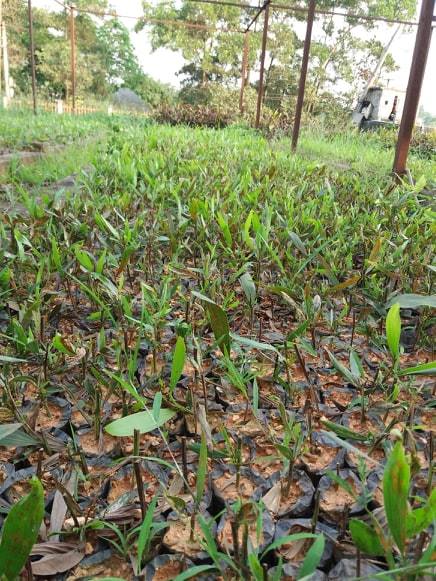Phytophthora acaciivora
|
Phytophthora spp. in subclade 2e: portion of the seven-loci ML phylogeny featuring the type cultures of 212 described species (by T. Bourret). Notice the position of P. acaciivora Ex-type CBS 138638. Gloria Abad, USDA S&T.
|
|
Phytophthora spp. in subclade 2e: Morphological Tabular key (PDF) and Tabular key legends (PDF) in IDphy2 KEY SECTION. Notice the data of P. acaciivora Ex-type CBS 138638. Gloria Abad, USDA S&T.
|
|
colony morphology after 7 d growth at 20ºC on CA, V8 agar, MEA and PDA (from left to right) |
|
persistent, semi-papillate to papillate, predominantly elongated ovoid sporangia; scale bar = 25µm |
|
Oogonia with wavy walls containing aplerotic oospores with large ooplasts which turn pale brown on maturity. Antheridia were exclusively amphigynous. Many oospores aborted after the formation of walls. scale bar = 25µm |
|
root and collar root leading to patchy seedling death |
Name and publication
Phytophthora acaciivora T.Q. Pham, T.I. Burgess & Q.N. Dang (2020)
Burgess TI, Dang QN, Le BV, Pham NQ, White D, Pham TQ. 2020. Phytophthora acaciivora sp. nov. associated with dying Acacia mangium in Vietnam. Fungal systematics and evolution 6 (1): 243–252.
Corresponding author: tburgess@murdoch.edu.au
Nomenclature
Mycobank
Etymology
named after its host, Acacia mangium
Typification
Type: VIETNAM, Tuyen Quang, from dying Acacia mangium seedlings, Mar. 2012, T.Q. Pham; holotype MURU 480
Ex-type: culture CBS 138638 = AMTQ1
Sequences of ex-type in manuscript: ITS KX011263, ß-tubulin MN991983, HSP90 KX011238, coxI MN991990, coxII KX011228, nadh1 KX011286
Ex-type in other collections
(ET) CBS 138638, AMTQ1
Molecular identification
Voucher sequences for barcoding genes (ITS rDNA and COI) of the ex-type (see Molecular protocols page)
Phytophthora acaciivora ITS rDNA, COI
Voucher sequences for Molecular Toolbox with seven genes (ITS, β-tub, COI, EF1α, HSP90, L10, and YPT1
(see Molecular protocols page) (In Progress)
Voucher sequences for Metabarcoding High-throughput Sequencing (HTS) Technologies [Molecular Operational Taxonomic Unit (MOTU)]
(see Molecular protocols page) (In Progress)
Sequences with multiple genes for ex-type in other sources
- NCBI: Phytophthora acaciivora
- EPPO-Q-bank: Phytophthora acaciivora
- BOLDSYSTEMS: Phytophthora acaciivora
Position in multigenic phylogeny with 7 genes (ITS, β-tub, COI, EF1α, HSP90, L10, and YPT1)
Clade clade:
a taxonomic group of organisms classified together on the basis of homologous features traced to a common ancestor
2e
Morphological identification
Colonies and cardinal temperatures
Colony colony:
assemblage of hyphae which usually develops form a single source and grows in a coordinated way
morphology on CA, V8A, MEA, and PDA was uniform and cottony with no distinctive growth pattern and smooth regular margins. except for rosaceous pattern on PDA. Minimum growth temperature 10°C, optimum 27.5°C, and maximum is greater than 37.5°C.
Conditions for growth and sporulation
SporangiaSporangia:
sac within which zoospores form, especially when water is cooled to about 10°C below ambient temperature; in solid substrates, sporangia usually germinate by germ tubes
are produced in water cultures (soil extract or river water) and not observed in solid media. OogoniaOogonia:
the female gametangium in which the oospore forms after fertilization by the antheridium
formed in paired cultures on CA and V8 after about 14 d.
Asexual phase
SporangiaSporangia:
sac within which zoospores form, especially when water is cooled to about 10°C below ambient temperature; in solid substrates, sporangia usually germinate by germ tubes
semi-papillate, persistentpersistent:
pertaining to sporangia that remain attached to the sporangiophore and do not separate or detach easily (cf. caducous)
, and of various shapes. SporangiaSporangia:
sac within which zoospores form, especially when water is cooled to about 10°C below ambient temperature; in solid substrates, sporangia usually germinate by germ tubes
averaged 56.3 x 13.4 µm (overall range 21–102 x 15–49 µm), external proliferationexternal proliferation:
formation of a sporangium after a sporangiophore has emerged from beneath and external to an empty sporangium that has previously emitted its zoospores (cf. internal proliferation)
. Sporangiophores simple, often laterally attached. Hyphal swellings absent. ChlamydosporesChlamydospores:
an asexual spore with a thickened inner wall that is delimited from the mycelium by a septum; may be terminal or intercalary, and survives for long periods in soil
absent.
Sexual phase
Heterothallic. OogoniaOogonia:
the female gametangium in which the oospore forms after fertilization by the antheridium
had wavy walls and size ranged from 24.5–46.2 µm. OosporesOospores:
zygote or thick-walled spore that forms within the oogonium after fertilization by the antheridium; may be long-lived
apleroticaplerotic:
pertaining to a mature oospore that does not fill the oogonium; i.e. there is room left between the oospore wall and oogonium wall (cf. plerotic)
, size ranged from 22.6–39.2 µm, over 90% aborted after the formation of the oosporeoospore:
zygote or thick-walled spore that forms within the oogonium after fertilization by the antheridium; may be long-lived
walls. AntheridiaAntheridia:
the male gametangium; a multinucleate, swollen hyphal tip affixed firmly to the wall of the female gametangium (the oogonium)
amphigynous
Most typical characters
Phytophthora acaciivora resides in cladeclade:
a taxonomic group of organisms classified together on the basis of homologous features traced to a common ancestor
2d and is closely related to P. frigida, P. elongata and P. acaciae. Compared to these species it has larger sporangiasporangia:
sac within which zoospores form, especially when water is cooled to about 10°C below ambient temperature; in solid substrates, sporangia usually germinate by germ tubes
and a temperature maximum for growth of over 37.5°C.
Specimen(s) evaluated
Vietnam, Tuyen Quang, from dying Acacia mangium seedlings T.Q. Pham, 2012, CBS 138638; CBS 138639: from canker of dying Melia azedarach, VTN18.
Hosts and distribution
Distribution: Vietnam
Substrate: roots and collar
Disease note: Phytophthora root and collar rot of young seedlings
Host: Acacia mangium, Melia azedarach
Additional references and links
- SMML USDA-ARS: Phytophthora acaciivora
- EPPO Global Database: Phytophthora acaciivora
- Forest Phytophthoras of the World: Phytophthora acaciivora
- CABI Digital Library: Phytophthora acaciivora
- Encyclopedia of Life (EOL): Phytophthora acaciivora
- Index Fungorum (IF): Phytophthora acaciivora
Fact sheet author
Treena Burgess, Ph.D., Phytophthora Science and Management, Harry Butler Institute, Murdoch University, Australia
Z. Gloria Abad, Ph.D., USDA-APHIS-PPQ-S&T Plant Pathogen Confirmatory Diagnostics Laboratory (PPCDL), United States of America





